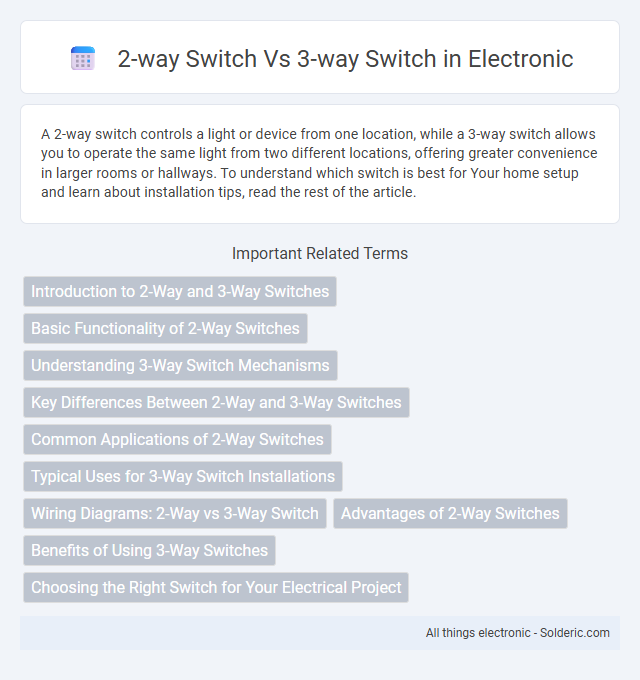A 2-way switch controls a light or device from one location, while a 3-way switch allows you to operate the same light from two different locations, offering greater convenience in larger rooms or hallways. To understand which switch is best for Your home setup and learn about installation tips, read the rest of the article.
Comparison Table
| Feature | 2-Way Switch | 3-Way Switch |
|---|---|---|
| Function | Controls a light from one location | Controls a light from two different locations |
| Number of Switches | One switch | Two switches |
| Wiring Complexity | Simple wiring | More complex wiring with travelers |
| Common Applications | Single room lighting | Hallways, staircases, large rooms |
| Switch Types | Single-pole switch | 3-way switch |
| Price | Generally lower cost | Higher cost due to complexity |
| Installation Difficulty | Easy for DIY | Requires knowledge of multi-way wiring |
Introduction to 2-Way and 3-Way Switches
A 2-way switch controls a single light or device from one location using two terminals, ideal for simple on/off functions. A 3-way switch enables control of one light or device from two different locations, employing three terminals and requiring two switches wired together. Both switches are essential components in residential and commercial electrical wiring, enhancing convenience and functionality in lighting control systems.
Basic Functionality of 2-Way Switches
A 2-way switch controls a single light or electrical device from one location, making it ideal for simple on/off functionality. It consists of two terminals where the electrical current flows through a single path. This setup is commonly used in bedrooms or small rooms where only one switch point is necessary.
Understanding 3-Way Switch Mechanisms
A 3-way switch allows control of a single light or set of lights from two different locations, using a combination of two switches connected through traveler wires. Unlike a 2-way switch that simply turns a light on or off from one point, the 3-way switch setup enables your home lighting to be more versatile and convenient. Understanding the internal mechanism, including the common terminal and traveler terminals, is key to troubleshooting or installing your 3-way switch system effectively.
Key Differences Between 2-Way and 3-Way Switches
2-way switches control a single light fixture from one or two locations, using two terminals for simple on/off operation, whereas 3-way switches enable control of a light from three or more locations with three terminals, incorporating a common and two traveler terminals for complex wiring. The main functional difference lies in the wiring configuration: 2-way switches use a single pair of wires, while 3-way switches require additional traveler wires to connect multiple switch points. Understanding these differences is essential for appropriate installation in residential or commercial lighting systems that demand multi-location control.
Common Applications of 2-Way Switches
2-way switches are commonly used in simple lighting circuits where a single switch controls one light fixture, such as in bedrooms, closets, and small rooms. These switches allow straightforward on-off control, making them ideal for basic lighting needs without complex wiring requirements. Your home's most frequent lighting setups often rely on 2-way switches for ease of use and installation.
Typical Uses for 3-Way Switch Installations
3-way switches are commonly used in stairways, long hallways, or large rooms where controlling a light fixture from two different locations enhances convenience and safety. These switches allow multiple access points to a single light, making them ideal for spaces that require flexible lighting control. Compared to 2-way switches, which control a light from a single location, 3-way switch installations provide greater functionality in residential or commercial lighting systems.
Wiring Diagrams: 2-Way vs 3-Way Switch
A 2-way switch wiring diagram involves two switches controlling a single light fixture with simple single-pole, double-throw (SPDT) switches, using two wires plus a ground. In contrast, a 3-way switch wiring diagram includes two 3-way switches connected by traveler wires, allowing control of one light from two different locations via a common terminal and two traveler terminals. Understanding your home's wiring setup helps you determine whether a 2-way or 3-way switch configuration best suits your lighting control needs.
Advantages of 2-Way Switches
2-way switches offer simplicity and ease of installation, making them ideal for controlling a single light from one location. Their straightforward wiring reduces the risk of electrical issues and maintenance costs compared to more complex 3-way switches. These switches are more cost-effective, providing reliable control without the added expense or complexity of multiple switch points.
Benefits of Using 3-Way Switches
3-way switches provide enhanced control by allowing a single light fixture to be operated from two different locations, improving convenience in large rooms, staircases, or hallways. They increase safety by enabling users to turn lights on or off from multiple entry points, reducing the risk of navigating dark areas. Compared to 2-way switches, 3-way switches offer greater flexibility and functionality in electrical wiring setups.
Choosing the Right Switch for Your Electrical Project
Choosing the right switch for your electrical project depends on the control points needed for your lighting. A 2-way switch controls a light from a single location, ideal for simple setups, while a 3-way switch allows control from two separate points, perfect for hallways or staircases. Understanding your space and how you want to operate your lights ensures efficient and convenient functionality.
2-way switch vs 3-way switch Infographic

 solderic.com
solderic.com